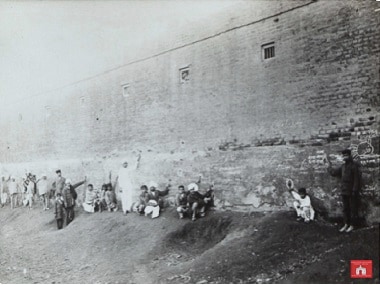Some places are designed to carry the weight of history: palaces, mausoleums, houses of gods. Then there are others: ordinary, everyday places that have history thrust upon them. The 6.5-acre garden close to Golden Temple in Amritsar is one such place. Till 4:30pm on April 13 one hundred years ago, it was just a dusty maidan. But a jittery Brigadier-General, Reginald Dyer, imprinted the name in the world’s memory. Even now, the number of dead remains contested — but few would suggest there is any room for moral ambivalence on the carnage. [caption id=“attachment_5529361” align=“alignleft” width=“380”]  Scene from the 1919 Jallianwala Bagh massacre[/caption] Yet, there’s a deeply disturbing question that India, today, is yet to address. In 1919 the British in India were on edge. The anti-Rowlatt Act agitation was at its peak; to the British, widespread insurrection seemed inevitable. Dyer killed in defence of the State, and the political values it represented. Independent India was built on rejection of those very values —but it kills just as surely. It isn’t hard to recount incident after incident where the Indian state has used savage force against its citizens. There was Operation Polo in 1948, which saw the Indian Army invade Hyderabad after the Nizam insisted on Independence. The Sunderlal Committee Report which was submitted in 1949 believed that anywhere between 27 to 40,000 people lost their lives during and after the ‘police action’ and also stated that the committee believed this to be a ‘conservative number’. Prime Minister Indira Gandhi, in 1966, ordered the bombing of Aizwal in an attempt to finish off the Mizo National Front. In 1990, CRPF troops opened fire on a crowd of Kashmiri protesters in what came to be known as the Gawkadal massacre, killing at least 28. In 2016, around 30 people were killed in an agitation by the Jat community in Haryana when the police opened fire. In 2017 a moral barrier was breached when Madhya Pradesh police opened fire on protesting farmers in MP’s Mandsaur. Six farmers died. And last year 10 people were killed when the police opened fire on the 100th day of protest against Sterlite Copper in Toothukudi, Tamil Nadu. Kashmir saw 127 unarmed protesters killed in police action in 2008; another 90 in 2015; and, almost unnoticed, 66 last year. In many, if not all, of these cases, force has been used against murderous mobs — but that field near the Golden Temple ought make every Indian ask why it is that violence is the only language the state has to address violence. The Indian Constitution safeguards the citizen’s right to protest. The article is subject to reasonable restrictions. Section 141 of the Indian Penal Code lays out guidelines for when a public assembly can term ‘unlawful’ or ‘unruly’. The state can use force to disperse such assemblies, but only with minimum loss to life and property. Firearms are a last resort. Mob violence is not, of course, an India-centric phenomenon. In 2011, violence erupted for an entire week in England following the death of Mark Duggan at the hands of the police. Five people died during the violence — none because of police action. The police were issued plastic bullets, but not a round was fired. In the recent Yellow Vest protests that rocked France, there were 10 fatalities but only one was because of police action. In most democracies, this is the norm: the use of lethal force by police is only legitimate when exercised, clearly, to save lives. In India, that is, unfortunately, not the case. Though protocols and drills govern the use of live-fire against mobs, poor training and antiquated crowd-control equipment often conspire to ensure killing is the only tool available to restore peace. Perhaps more important, controlling violent crowds isn’t an end in itself. The objective isn’t to stop protesters breaking the law; it is to uphold the laws of the State. In the United Kingdom and France, thousands of arrests, prosecutions and prison sentences followed the violence — enabled by technologies like closed-circuit television and old-fashioned, stomping-the-streets police work. In India, few rioters have ever been punished. In Kashmir, the number of successful prosecutions for mob violence is zero. The sad fact is that successive governments hasn’t led to an influx of new equipment, either. In Kashmir, this willingness to kill has had demonstrable costs. Local recruitment into terror outfits has been on an increase, from 21 in 2013 to 202 in 2018. Put simply, shooting dead unarmed protesters isn’t aiding the fight against terrorism, it is creating more. Irrespective of the moral rights and wrongs of the mob’s causes or actions, the indiscriminate use of force is clearly making the challenge before security forces worse, not better. Embedded attitudes, unchanged since independence, are part of the problem. The scholar Thomas Blom Hansen says that to the colonial powers the Indian mob was a , “faceless, aggressive, unfathomable, irrational compact of people…beyond the comprehension of colonial sociology”. Along with its style of policing, which is heavily built on a fear of the baton, the Indian police has inherited this attitude; where the crowd is a faceless beast imbued with destructive energy and the only way to deal with it is to either get out of it way or shoot at it. Perhaps the centenary of Jallianwala Bagh is as good a time as any for the State to reflect upon the way it deals with its citizen’s protests and where it needs course correction.
Centenary of Jallianwala Bagh massacre led by General Dyer is as good a time as any for the State to reflect upon the way it deals with its citizen protests and where it needs course correction
Advertisement
End of Article


)

)
)
)
)
)
)
)
)



